
Original Link: https://www.anandtech.com/show/5270/silverstone-precision-ps07-temjin-for-less
SilverStone Precision PS07: Temjin For Less?
by Dustin Sklavos on January 3, 2012 12:20 AM EST- Posted in
- Cases/Cooling/PSUs
- SilverStone
- MicroATX
- Mini-Tower
We were big fans of SilverStone's Temjin TJ08-E when we reviewed it back in August. Who wouldn't be? Even SilverStone was surprised at just how effective the little enclosure was, producing better cooling and acoustics than their own substantially more expensive Fortress FT03. Today SilverStone comes to us with a modified Temjin TJ08-E--modified for a lower price point. The Precision PS07 is almost identical to its predecessor internally, but SilverStone has cut some corners to shave about $20 off the end retail cost. Was it worth the sacrifice?
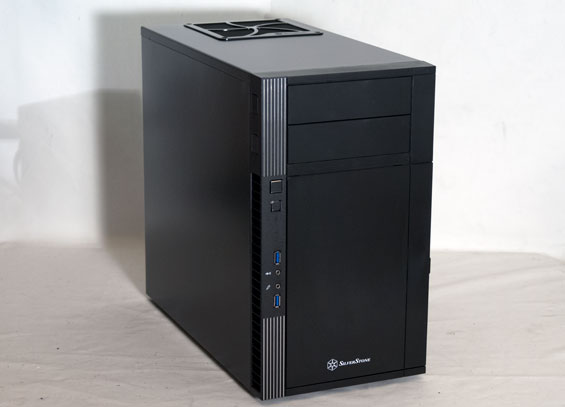
It's easy to be a little underwhelmed by the PS07. The difference between $79 and $99 just doesn't feel like a very big one, but when you're working on a budget, every little bit can help. SilverStone has also moved a couple of things around in the fascia and changed the internal fan configuration in the process. The result is a case that feels very similar but it has a few differences, some more important than others.
| SilverStone Precision PS07 Specifications | ||
| Motherboard Form Factor | Micro-ATX, Mini-ITX | |
| Drive Bays | External | 2x 5.25" |
| Internal | 5x 3.5", 1x 2.5" | |
| Cooling | Front | 2x 120mm intake fan |
| Rear | 1x 120mm fan mount | |
| Top | - | |
| Side | - | |
| Bottom | - | |
| Expansion Slots | 4 | |
| Front I/O Port | 2x USB 3.0, headphone and mic jacks | |
| Top I/O Port | PSU vent | |
| Power Supply Size | ATX | |
| Clearance | 13.25" (Expansion Cards), 150mm (CPU HSF), 160mm (PSU) | |
| Weight | 11.47 lbs. | |
| Dimensions | 15.75" x 8.27" x 14.73" | |
| Price | $79 | |
Spec wise, the Precision PS07 is virtually identical to its predecessor, although SilverStone kills the dedicated external 3.5" bay entirely. That's not a major sacrifice; placement of the bay was so awkward to begin with that I wouldn't expect it to have seen much use. The one major change is SilverStone has removed the 180mm Air Penetrator (I challenge anyone with a juvenile sense of humor not to giggle at the name) fan and replaced it with two generic 120mm intake fans.
In and Around the Precision PS07
Whoa, deja vu. If you were paying attention to our review of the Temjin TJ08-E, SilverStone's Precision PS07 is going to seem very familiar once you pop it open. The differences between the two largely start and stop at the front fascia.
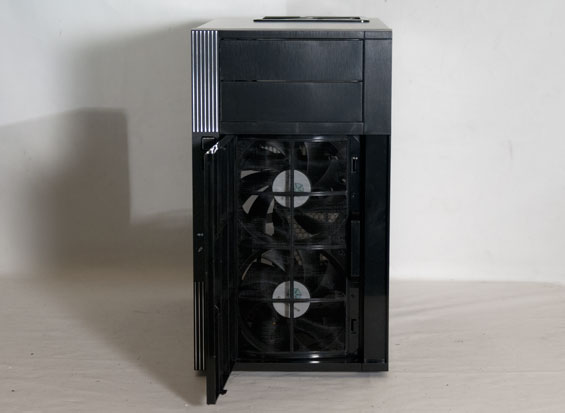
That's unfortunate, too, because while the PS07's face is certainly attractive enough on its own, it undeniably feels cheaper than its progenitor. Gone is the black brushed aluminum, replaced by matte black plastic with silver accents along the left side. What we do get, though, is a solid front finish, with ventilation along the sides instead of directly in front of the fans. There's also a door that hinges out, allowing you to access the filter for the two 120mm intake fans. All of the plastic is still of fine quality, and SilverStone kept the USB 3.0 connectivity, but it's hard not to miss the classy exterior of the TJ08-E.

The differences between the PS07 and TJ08-E pretty much end there. For a refresher, though, when you circle to the back you'll notice the power supply is where it used to be in older style enclosures: at the top instead of the bottom. This is coupled with an inverted motherboard design, placing the board against the left side of the case instead of the right. The net result is that the intake fans create a wind tunnel that fires straight through the enclosure, making the PS07 particularly ideal for tower-style coolers.
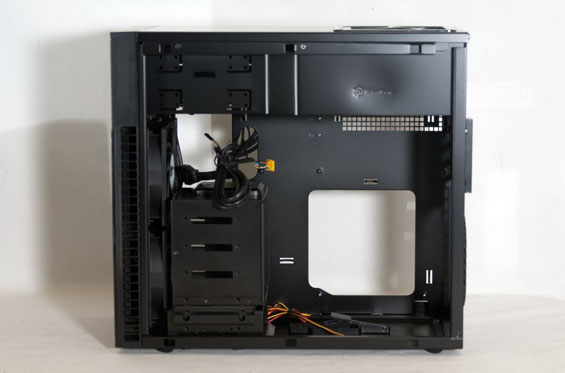
SilverStone uses thumbscrews to secure the side panels, and when you pop them off you'll see virtually nothing internally has changed. I'd venture to guess SilverStone is actually using the exact same chassis for the majority of the PS07. The top panel is still fastened by six screws, unfortunately, and you still need to remove it to assemble the system. The motherboard tray is removable, as is the drive cage, and drives are oriented front-to-back instead of laterally.
For better or worse, this is the same internal design as the TJ08-E, with the major change being the switch from a single 180mm Air Penetrator fan to two 120mm fans. That's also the change I'm least happy with, though I understand why it was made. The problem is that the Air Penetrator fan's unique grille design also ensured cabling would never get caught in the fan blades, something you'll have to watch out for with the more open 120mm fans.
Assembling the SilverStone Precision PS07
Once again, the SilverStone Precision PS07's assembly was another exercise in deja vu. SilverStone includes an instruction manual that details a very specific way to assemble the enclosure from start to finish to make things as easy as possible, and for the most part it's on the mark. Their cases often feel like puzzles with very specific solutions, and thankfully you don't have to figure them out on your own.
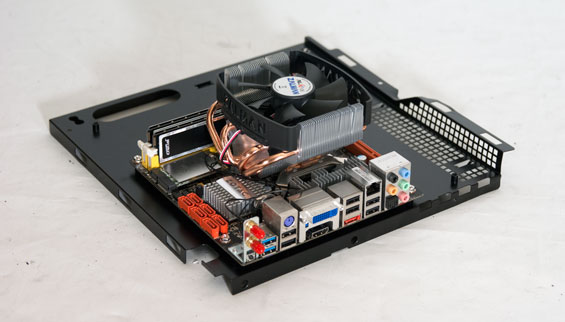
The PS07 comes apart in a few different places. You won't have to remove the front fascia, but the side panels, top panel, motherboard tray, and drive cage all come out. You don't necessarily have to do all of these things, but they can help. SilverStone includes standoffs built into the motherboard tray that makes mounting the board a breeze, but I found locking the tray back into place to be on the awkward side. When I assembled the TJ08-E I opted not to remove the tray to install the board, and that turned out to be the right choice. With the more easily removable drive cage it's simply not necessary.
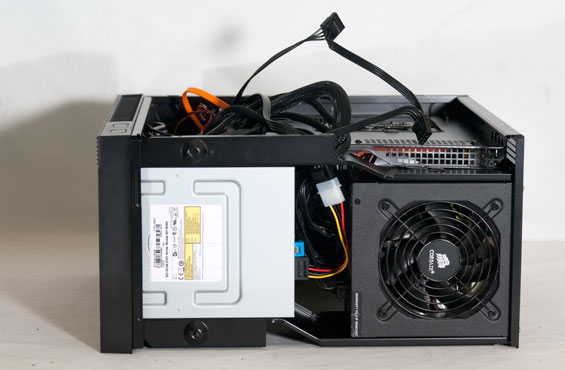
While ordinarily the power supply is one of the last things I'd install, it pays to pop it into the PS07 early. One of the last things to go in should actually be the optical drive, as you run the risk of dealing with some cable clearance issues in the PS07. Theoretically you can get a 180mm power supply into this enclosure, but honestly you'll want to use a 160mm unit instead like I did for this review build. This is also a situation where using a non-modular power supply may actually be beneficial; there's space behind the motherboard tray to stash excess cables, and modular connections in the PSU can add to the overall length of the unit.
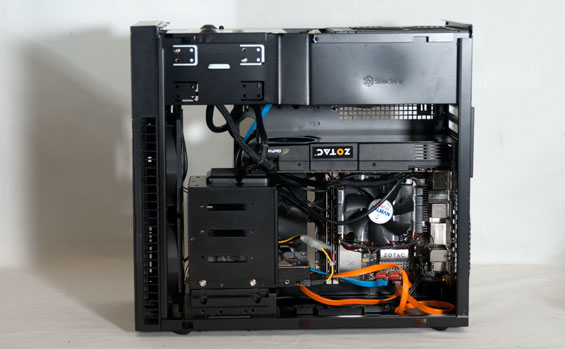
If you're using a tower-style cooler for the CPU heatsink, you'll have to remove the hard drive cage to install 3.5" drives. There's a mount on the bottom of the enclosure for a single 2.5" drive (SSD, naturally), and the ports of the drive line up with the anterior of the motherboard tray nicely, making it reasonably easy to wire. Finally, getting a card like our GeForce GTX 580 in may require some work depending on your motherboard layout, but I found most of the effort involved was the result of our Zotac board packing things in too close to the PCI Express x16 slot.
Given the close quarters of the PS07, the build remains nonetheless surprisingly clean. This isn't the easiest case in the world to assemble, but for its somewhat unusual design there's still a clear logic to how things come together. It's a sharp contrast against some of the Lian Li enclosures I've tested recently, where Lian Li's engineers seem to have their own internal logic they're going to work off of whether the rest of us understand it or not.
Testing Methodology
For testing Micro-ATX and Mini-ITX cases, we use the following standardized testbed in its stock configuration and a Zotac GeForce GTX 580 in cases that support it to get a feel for how the case handles heat and noise. Due to the power supply clearance constraints of the TJ08-E, SilverStone provided us with a slightly different PSU for testing.
| Mini-ITX/Micro-ATX Test Configuration | |
| CPU | Intel Core i3-530 (73W TDP) |
| Motherboard | Zotac H55ITX-WiFi |
| Graphics Card | Intel HD Graphics (IGP) |
| Memory | 2x2GB Crucial Ballistix Smart Tracer DDR3-1600 |
| Drives |
Samsung 5.25" BD-ROM/DVDRW Drive Kingston SSDNow V+ 100 64GB SSD Western Digital Caviar Black 1TB SATA 6Gbps |
| CPU Cooler | Zalman CNPS8000A with Cooler Master ThermalFusion 400 |
| Power Supply | Corsair AX850 80 Plus Gold Modular PSU |
A refresher on how we test:
Acoustic testing is standardized on a foot from the front of the case, using the Extech SL10 with an ambient noise floor of ~32dB. For reference, that's what my silent apartment measures with nothing running, testing acoustics in the dead of night (usually between 1am and 3am). A lot of us sit about a foot away from our computers, so this should be a fairly accurate representation of the kind of noise the case generates, and it's close enough to get noise levels that should register above ambient.
Thermal testing is run with the computer having idled at the desktop for fifteen minutes, and again with the computer running both Furmark (where applicable) and Prime95 (less one thread when a GPU is being used) for fifteen minutes. I've found that leaving one thread open in Prime95 allows the processor to heat up enough while making sure Furmark isn't CPU-limited. We're using the thermal diodes included with the hardware to keep everything standardized, and ambient testing temperature is always between 71F and 74F. Processor temperatures reported are the average of the CPU cores.
For more details on how we arrived at this testbed, you can check out our introductory passage in the review for the SilverStone FT03.
Last but not least, we'd also like to thank the vendors who made our testbed possible:
Thank You!
We have some thanks in order before we press on:
- Thank you to Crucial for providing us with the Ballistix Smart Tracer memory we used to add memory thermals to our testing.
- Thank you to Zalman for providing us with the CNPS8000A heatsink and fan unit we used.
- Thank you to Kingston for providing us with the SSDNow V+ 100 SSD.
- Thank you to CyberPower for providing us with the Western Digital Caviar Black hard drive and the optical drive.
- Thank you to Corsair for providing us with the AX850 80 Plus Gold power supply.
Noise and Thermal Testing, IGP
The crucial difference between the SilverStone Precision PS07 and the Temjin TJ08-E is going to be the pair of 120mm fans in the Precision against the single high-quality 180mm fan of the Temjin. That makes for an interesting comparison, since we can see just how much of a difference going with two smaller fans can make.
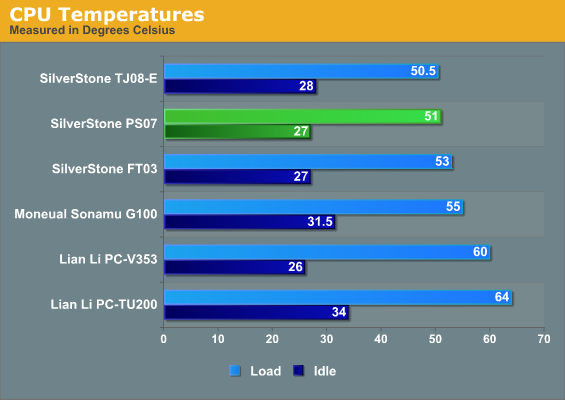
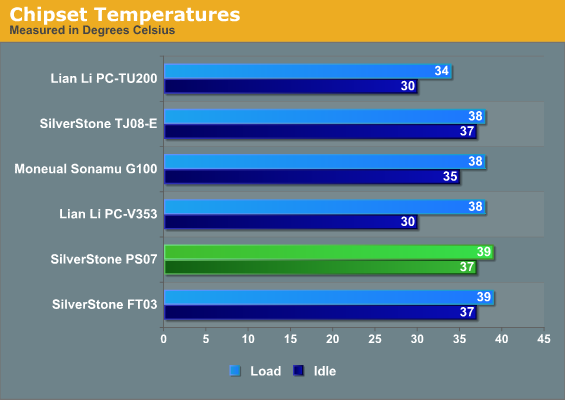
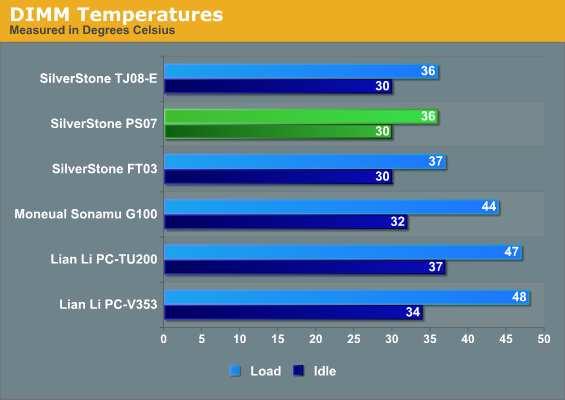
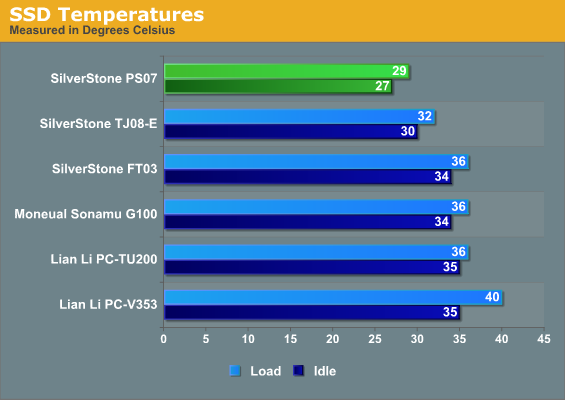
The answer to that question? Not much difference. Performance between the two is essentially comparable, though it bears mentioning SilverStone's more sensible (if bulkier design) does pay dividends compared to the more esoteric designs of the two Lian Li enclosures we've tested.
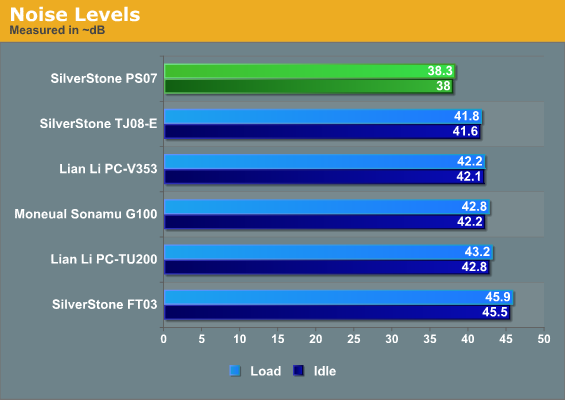
Meanwhile, noise levels are actually down substantially compared to the TJ08-E. There may yet be something to this new design, though the character of the noise is definitely a bit more intrusive compared to the TJ08-E's louder but lower-pitched hum.
Noise and Thermal Testing, GeForce GTX 580
Given the overall differences (or lack thereof) between the SilverStone Precision PS07 and Temjin TJ08-E demonstrated on the previous page, it'll be interesting to see if adding a GeForce GTX 580 to the mix changes things at all. Airflow is similar between the two cases but not identical, and the GTX 580 may wind up highlighting differences in the way air is channelled.
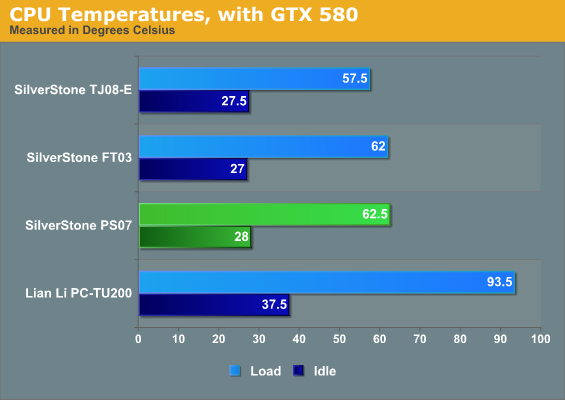
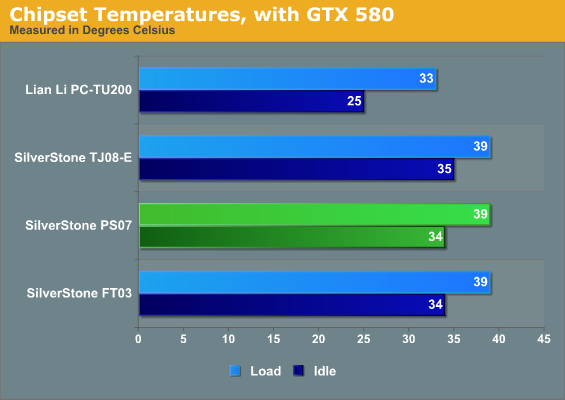
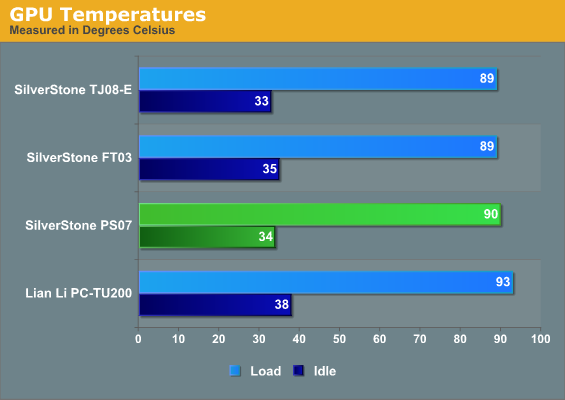
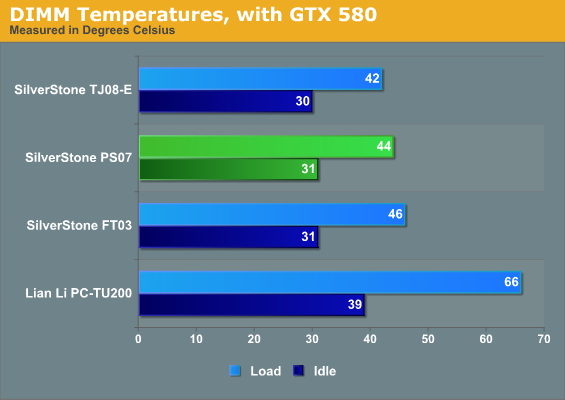
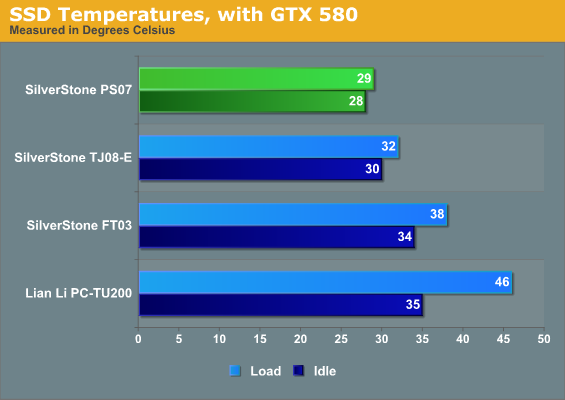
Sure enough, it does. Important components run ever so slightly cooler in the TJ08-E. It's pretty close to the margin of error in most instances, but the CPU runs appreciably cooler in the more expensive enclosure while the SSD runs cooler in the PS07. Under the circumstances, I'll take the cooler processor any day.
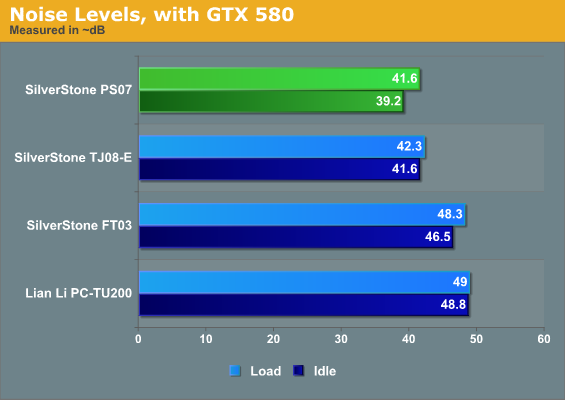
Once again the PS07 wins in acoustics, but it's nowhere near as much of an improvement as it was without the GeForce. Again, the character of the PS07's fan noise is a little higher-pitched than the TJ08-E's. Under the circumstances I think I'd still take the TJ08-E.
Conclusion: Is It Worth the Difference?
With the SilverStone Precision PS07, I'm having a difficult time determining whether or not it's worth saving the $20 over their already awesome Temjin TJ08-E. The TJ08-E already ranks as one of my favorite enclosures of the year and probably my favorite Micro-ATX enclosure, so why wouldn't I heartily endorse making that same great internal design more readily available by producing a less expensive version?
Thermally and acoustically, SilverStone's design is fantastic. Airflow is brilliantly handled, and I've actually assembled the TJ08-E with a tower cooler in a build for a friend. The results there were just as impressive, with the overclocked i5-2500K running coolly and quietly. If it has a flaw, it's probably GPU cooling. Thermals on the GTX 580 just weren't that good, but a more reasonable card (like a GeForce GTX 560 Ti or AMD Radeon HD 6870) would probably be right at home. Either way, this is definitely a capable mATX enclosure.
The problem is that I'm just not sure the PS07 is worth the savings. Keeping stray cables out of the 120mm fans is a minor problem, but the fans themselves actually feel a lot cheaper, and over testing one developed a minor rattle. If you're comfortable replacing the fans the PS07 is probably great, but the problem there is that your end cost starts getting close enough to the Temjin that there's not much point in the initial savings unless you already have the fans.
Ultimately, my problem is SilverStone's problem. In a vacuum the Precision PS07 is a fantastic case, absolutely worthy of consideration for your next Micro-ATX build. Yet the Temjin TJ08-E it's based on is still around, and while the Temjin is $20 extra, it also features a fan controller for the single 180mm intake fan, a classier aluminum bezel, and an improved noise character. It's up to you to decide whether you think the PS07 is worth the savings; I don't think so, but I wouldn't fault anyone who did.



















